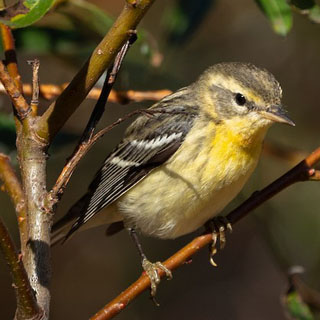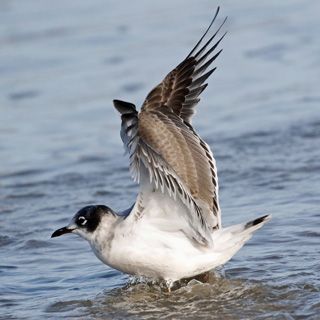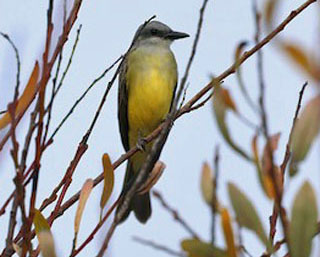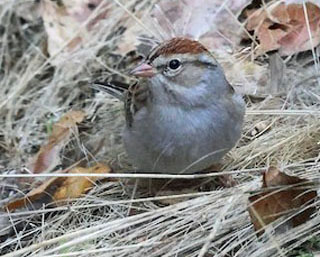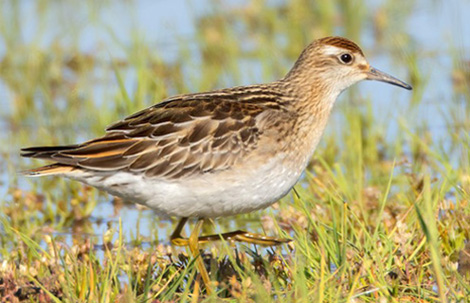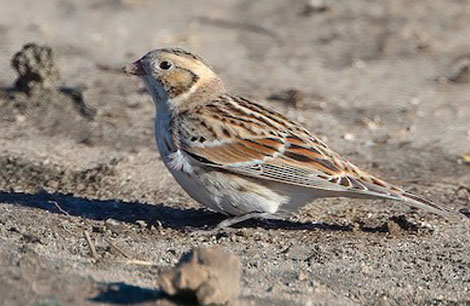These highlights chronicle the year 2023. The year runs generally
"backwards" on this page. In crediting records of vagrant or unusual birds, I always try to credit the finder(s) of the rarity. There will be times when complications arise with credit (e.g., one or more observers find a bird but others are the ones to actually identify it). There are times when a bird is properly identified only days later after photo review.
As more and more observers carry digital cameras, most rare birds in Monterey County are now photographed. Although I continue to write seasonal summaries for North American Birds magazine (now published by the American Birding Association), there is just not enough volunteer time to produce complete seasonal reviews here. I'm only going to include the "cream of the crop" that have photos, and a smattering of other birds that piqued my interest. The vast majority of birds I've not included here for this time period are available in eBird.
The abbreviation "MTY" means "Monterey County"
in the text below. Text by Don Roberson. Photos on this page
are copyrighted by the photographers to whom they are
attributed, and may not be reproduced in any form (including
other web sites) without the express consent of the photographer. |
| |
| The Monterey Peninsula Christmas Bird Count (CBC) took place on 27 Dec 2023, continuing a Monterey Audubon tradition for over 80 years. Rita Carratello was the organizer and compiler; Amanda Preece will post the results on National Audubon's CBC web page. Perhaps 50 observers in 16 territories (plus multiple sub-territories & feeder watchers) participated during overcast weather, with threatened rain not arriving until 3:45 p.m. The results yielded 178 species — a "good" count locally, and bettering most recent CBCs. Even though the boat portion of the count circle was canceled, on-shore seawatchers did well, including a Tufted Puffin from Pt. Pinos (Mark Kudrav). This good total includes a wide variety of rarities, most of them found before the count and that are wintering; some lingered through December but did not winter; and a few that were discovered during the CBC. An eBird Trip Report is available (it stills needs editing to avoid over-counts for species like Snow Goose and the lone Franklin's Gull, which were reported from multiple parties). A gallery of highlights is below, labeled clockwise from upper left: |
|
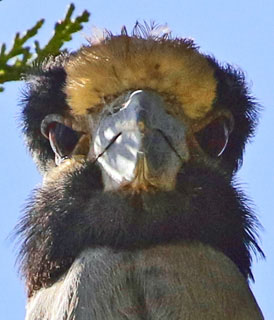 |
- Blackburnian Warbler: found 30 Oct (Casey Foley) in Pacific Grove (ph 6 Nov, Carole Rose); not seen after 28 Dec
- Franklin's Gull: found 2 Dec in Harbor by Woody Goss from Chicago and wintering; photo 2 Jan (D. Roberson)
- Lucy's Warbler: found at El Estero on CBC (ph Paul Fenwick); black on face is pollen from flowering eucs
- Yellow-bellied Sapsucker: juv found on CBC in Pacific Grove, same tree as last winter's adult (ph Francis Toldi)
- Chipping Sparrow: found on CBC (ph Bill Hubick), a one-day wonder; no proven winterer ever for MTY
- Black Scoter: young male in Harbor since 2 Dec, photo 3 Dec (Mark Chappell)
- Tropical Kingbird: returning in October for 5th winter, photo from CBC on 27 Dec (Bill Hubick)
- Yellow-crowned Night Heron: more below! (ph D. Roberson)
|
 |
|
|
|
| As usually happens, some known wintering birds were missed on the count, and then were refound later in December-January, including a Long-tailed Duck at Monterey Harbor (more on it below) and another Lucy's Warbler at Laguna Grande. Outside the count circle, rare large gulls at the Marina Landfill in late December included Glaucous (21-28 Dec), third-cycle Lesser Black-backed (28 Dec), and a first-winter Slaty-backed (21-28 Dec; all gulls found & photo'd by Brian Sullivan). Field characters of the latter in first-cycle plumage remain controversial, but consensus appears to support well-photographed examples. There are now 9 MTY records of Slaty-backed Gull, in a wide range of age classes, with 3 from Pt. Pinos and 4 from the Marina Landfill. |
| |
 |
 |
At sunset on Friday, 15 Dec, a crowd of local observers stopped by Monterey Audubon's Pt. Pinos Seawatch to say goodbye and best wishes to Alison Világ, our expert sea-watcher from Michigan. This was her second year in this position after her survey work here last year. Alison stood at the Point, dawn to dusk for six days each week during the six week survey (1 Nov-15 Dec 2023; MAS volunteers covered Sundays). Many noted that with the change of the exact location to the northwestern-most parking lot of Pt. Pinos, more visitors stopped to engage with MAS volunteers as Alison scanned the seas.
This was the eighth year of the Seawatch (Covid canceled the effort in 2020), and the primary focal species were in good numbers this season, with ~154,000 Pacific Loons and 62,900 Surf Scoters. We've learned that each year is different, both in weather and sea conditions, and in the timing and number of migrants. In 2015 and 2016 the Seawatch tallied Pacific Loons at over 200,000. Has the population diminished? Or did our chosen 6 weeks not catch the peak of the migration? Yet scoter numbers were higher than ever, and among them were 50 White-wings and 30 Blacks, plus 7 Long-tailed Ducks and one Harlequin Duck.
Interesting vagrants spotted by Alison included flocks of Red Crossbill coming from off the sea, a Short-eared Owl, and a Prairie Falcon. |
|
|
| |
 |
 |
The parking lot at the private Beach Club at Pebble Beach's Stillwater Cove is lined by a row of tall cypresses (above, photo © D. Roberson), reaching almost to the cove itself. For many years they have been used as a day-roost for local Black-crowned Night Herons. On 5 Dec, Sarah Lane and husband Jerry Stengel visited the public access to the pier at Stillwater Cove and Sarah found MTY's first ever Yellow-crowned Night Heron! This generally cooperative heron roosted during the day in cypresses (often at a favored spot; photos above right & just below, both 7 Dec © Mark Chappell), but it would 'disappear' into the foliage at times. It was still present in late January 2024.
This is one of the best documented rarities ever, with new photos almost every day. It is especially interesting in late afternoon, towards sunset (right), when it forages for crabs and shoreline critters, as do the Black-crowns. Photos showing flight and leaving the roost are just below right (10 Dec © Alex Rinkert), bottom row left (16 Dec © Carole Rose), and bottom row right (16 Dec © D. Roberson). |
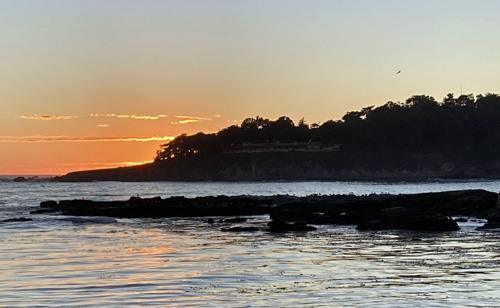 |
 |
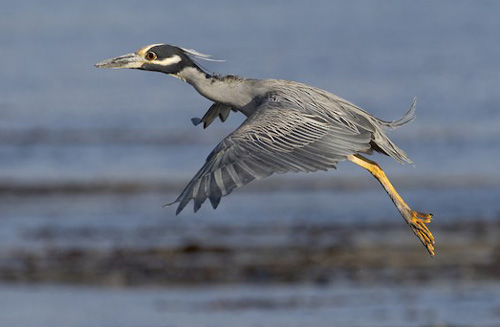 |
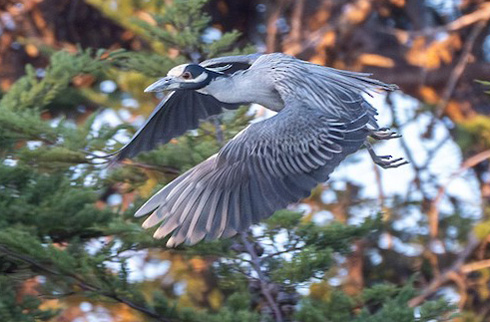 |
 |
|
| |
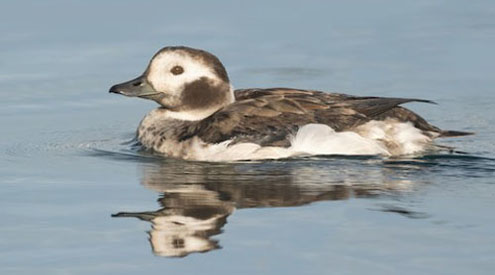 |
| On 28 Nov, Jeerapa Sookgaew discovered a hatch-year Long-tailed Duck in Monterey Harbor. At least initially, it spent much of its time in a tidal channel between the Marina and the public walkway between Fisherman's Wharf and the Commercial Wharf. The clear shallow waters here permitted observers to watch the duck foraging among the algae-covered rocks, fully underwater, as if watching in an aquarium (photo right, 2 Dec © Don Roberson). By the New Year, the duck had molted into a crisper, paler first-winter plumage (photo above, 12 Jan 2024 © Mark Chappell). |
|
 |
|
| |
| After the flood of almost-daily new vagrants, November 2023 was comparatively quiet. An off-and-on Neotropic Cormorant around Moss Landing was an adventure from at least 1-7 Nov (Carole Rose, et al.). Perhaps most interesting was the lengthy visit of two Sharp-tailed Sandpiper at the Salinas WTP (permit access only). It all started on 14 Oct, when Steve Tucker — chasing and finding a reported Sage Thrasher there — discovered the two Sharp-tails, which quickly flushed. Shortly thereafter one of the juv Sharp-tailed Sandpiper (left just below) began foraging next to a juv Pectoral Sandpiper (right bird just below, next to a Least Sandpiper), providing an opportunity to show both in the same frame (photo 14 Oct, © Don Roberson); note the Sharp-tailed's mostly unmarked orange breast and redder cap. For weeks thereafter, permitees found one or both of the Sharp-tails, all the way to 11 November. On 11 Nov, Mark Chappell photographed each at close range: note differences in details of breast pattern and color, and particularly the extent of rusty edging on the tertials (both © M. Chappell). |
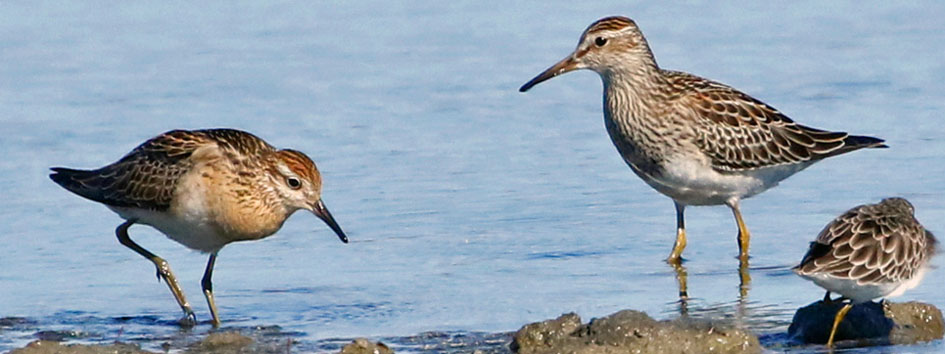 |
|
| Wastewater ponds and post-harvested ag fields are perfect habitats for migrant longspurs. This fall a Chestnut-collared Longspur was at the Salinas WTP from 21 Oct-5 Nov (Bill Hubick et al., photo left, just above © D. Roberson). A harvested ag field adjacent to Zmudowski SB hosted up to 3 Lapland Longspur from 12-23 Nov (Steve Tucker, photo right, just above © Andrew Kenny). A wayward Lapland Longspur that circled a boat in the middle of Monterey Bay on 8 Oct (Bernardo Alps et al.), over the underwater Soquel Canyon, is properly assigned to MTY by California statutes. |
|
|
 |
As grateful as birders were for prolonged visits by a Yellow-crowned Night Heron (above) and a Broad-billed Hummingbird (below), the most frustrating and yet exhilarating bird of the fall might have been this juv Common Greenshank (right, © Irene Rosen). On 25 October, Ms. Rosen was engaged in a botanical survey at “upper Twin Lake,” the larger of two closely-set vernal pools named “Twin Lakes”, with water in it due to recent rains. The waders present were a Killdeer, 5 Greater Yellowlegs, and this Greenshank. But it was not identified until later, from photos. By the time word got out it was dark, so there was a huge effort the next day to search all of Fort Ord’s ponds, most of them miles from roads (see below a map of all the vernal pools and trails in northern Fort Ord National Monument, near Marina; "upper Twin Lake" is labeled), but all had to be checked. No one turned up the Greenshank.
It seems probable that this MTY greenshank was the same individual that was present in Del Norte County, near the Oregon border, for a month; last seen 17 Oct. If it is the same bird, it was just the third to appear in the entire State of California (CBRC 2007 + eBird since). It thus is one of those absolutely great MTY birds that were only seen and photographed by one person (e.g., see also Northern Gannet, Yellow-footed Gull).
|
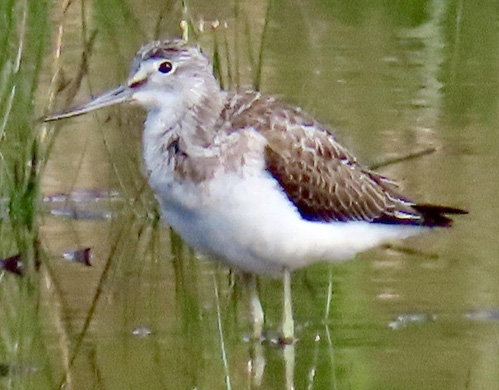 |
|
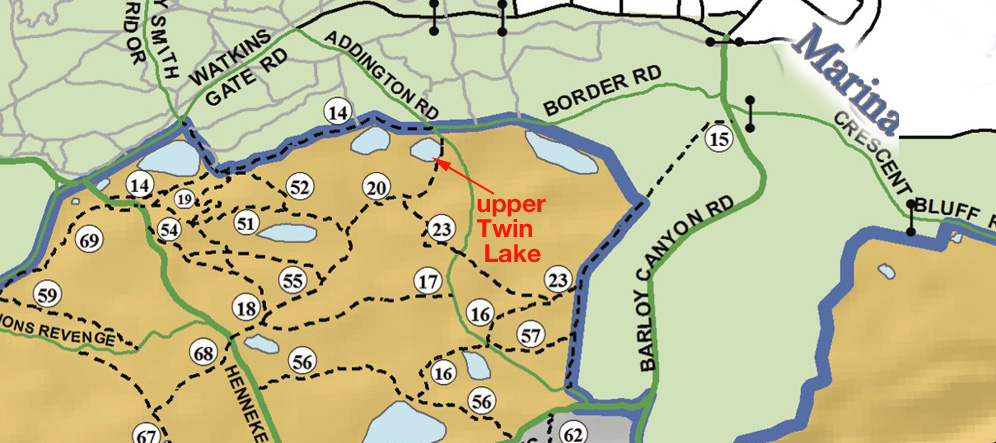 |
|
| |
 |
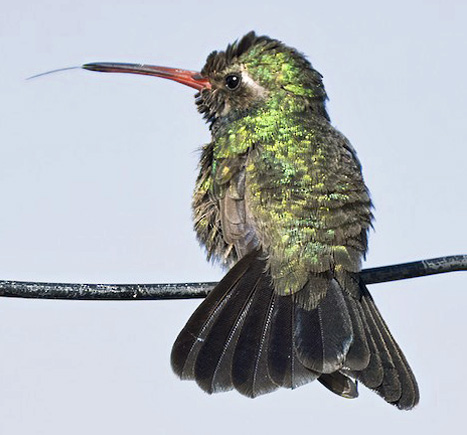 |
Earthbound Farms is a nursery on Carmel Valley Road, just east of Quail Lodge, that features plants, produce, and a cafe. In mid-October the west edge of the parking lot was ablaze with flowering Salvia, including this patch (above) that workers called Phyllis's Fancy, a hybrid involving 'Mexican Salvia.' On 19 October, Bill Hill was here to buy pumpkins, and discovered this male Broad-billed Hummingbird (above, photo 19 Oct © Bill Hill). The very active first-year male perched often on a wire fence above the flowers. Although smaller than most hummers, it was aggressive and pugnacious, combating various Anna's. It foraged rapidly on blooms, sometimes giving a rapid 'je-dit' call that recalled Ruby-crowned Kinglet. Perhaps because the flowers were close to cars in the parking lot, hummingbirds seemed oblivious to us, often landing right next to photographers.
A combo of many photos revealed a USFWS band on its right leg that read U11664 (photo right, 28 Oct, © D. Roberson). It is now confirmed that a Broad-billed was banded with this number on Pt. Reyes, Marin Co., on 17 Oct, just 2 days before our bird was found (fide Ethan Monk, forwarding Point Blue post). Our cooperative male stayed to 30 October, providing MTY's 4th record, all of them falling between 29 Sep–9 Nov. |
|
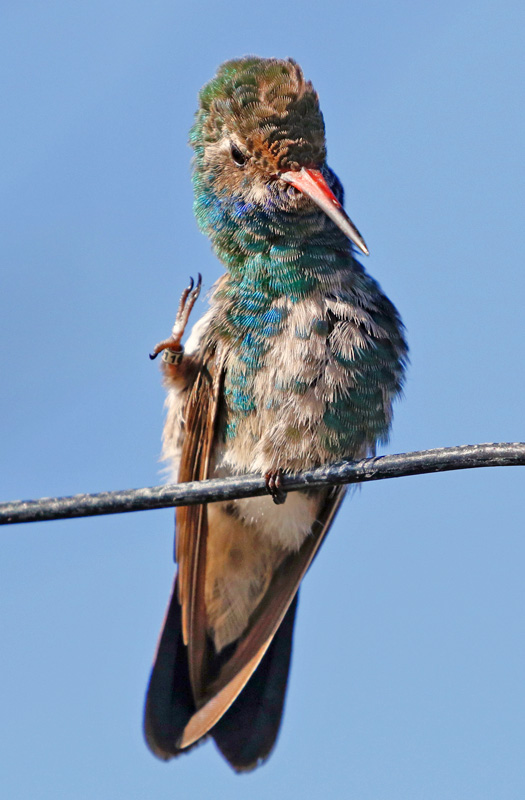 |
|
|
| |
 |
Two excellent vagrants visited Pacific Grove in October, each seen by lots of observers. Bill Hubick found this male Black-throated Blue Warbler in the El Carmelo Cemetery on 23 Oct, and it remained through 26 Oct (photo left on 23 Oct, © Don Roberson).
Steve Tucker discovered this Sage Thrasher at Pt. Pinos on 22 Oct, and it remained to 3 Nov (photo right on 31 Oct, © Mark Chappell). This is the first ever at well-worked Pt. Pinos! Three other Sage Thrashers were encountered at Carmel River SB, suburban P.G., and near Salinas. |
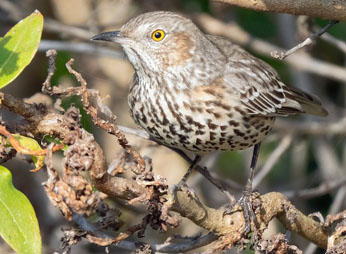 |
Last fall was impressive for its number and variety of eastern warblers.
The web page
for autumn 2022 included charts comparing that season's
numbers of 'eastern warblers' to the "average" showing each fall over
the past ten years.
At least a dozen 'eastern warblers' were 'above average'
to 'best fall ever' in 2022.
In 2023, we recorded 14 species of
'vagrant eastern and southwestern warblers'
but had only one that was
missed in 2022 (two Black-throated Blues) while missing 5 species that
were found in 2022 (Kentucky, Pine, Prairie, Prothonotary, Bay-breasted).
We had 7 warblers in "average" or "below average" numbers, 3 were "above
average (Black-and-white, Tennessee, Blackburnian) and 4 rarities that
average fewer than 1/year (two Lucy's, two Black-throated Blue [a female
on the Pajaro River in Santa Cruz was seen to fly into MTY briefly], one
Mourning, one Canada).
Still, local birders considered fall 2023 to be
excellent. This season had an amazing diversity beyond warblers: from
ducks to gulls, hummingbirds to corvids, shorebirds to herons to flycatchers.
It even had an odd leucistic Dunlin (right, photo 5 Oct near Salinas, © D. Roberson).
|
 |
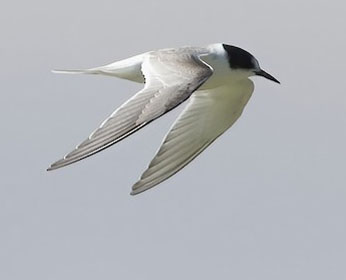 |
Almost everyone likes rare vagrants from the East, Siberia, or Mexico, but a generally unappreciated vagrant is a seabird that rarely appears on freshwater or inland. Two really good vagrants were this Arctic Tern on 13 Sep (left, photo © Terence Degan), and this juv Sabine's Gull, found by Kent Van Vuren on 1 Oct (photo right on 5 Oct, © Paul Fenwick), both from the permit-access-only Salinas WTP. Steve Rovell saw a Brown Pelican in flight over Hwy 101 on 15 Sep, south of Greenfield, and well inland.
|
 |
|
|
|
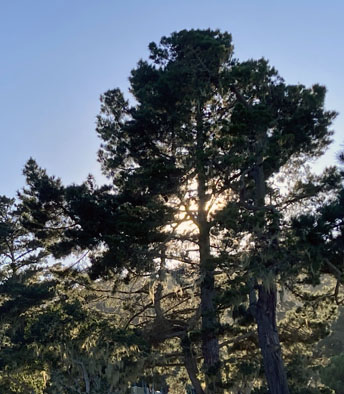 |
The autumn of 2023 produced a significant incursion of Clark's Nutcracker towards the California coast, dispersing them far from their montane ranges. On 5 Oct, this flight reached MTY, when Andrew Lawrence encountered a flock of 20 on Fort Hunter Liggett. On 15 Oct, Frank Verga, who resides among the tall Monterey pines in the Skyline Forest near Hwy 68 (above), heard and saw nutcrackers! This event, on the Monterey Peninsula, attracted locals who documented a group of 3 through 20 October. The nutcrackers were amazingly secretive and hard to observe when foraging in the highest canopies for pine nuts (photo upper left on 16 Oct, © Rita Carratello) but were noisy and raucous in flight (lower left on 16 Oct, © Don Roberson).
This is the 16th incursion in MTY, going back to 1903. The most recent was from Oct 1996 to Apr 1997, when up to 13 were atop Jacks Peak, and 15 more were on Cone Peak in southern MTY. |
|
|
| |
As we turned the calendar from Sep to Oct, two sought-after rarities were present. At Andrew Molera SP, a Philadelphia Vireo found by Steve Tucker on 23 Sep was still present in the tall riparian trees at the parking lot (photo far right, taken 2 Oct © Steve Tucker). In the Pacific Grove cemetery, a skulking Gray Catbird, found by Paul Fenwick on 30 Sep (photo near left, © Paul Fenwick), and mentioned last report, was there to 1 October.
There are now 25 MTY records for "Philly Vireo," and 16 records for Gray Catbird. Both species were once reviewed by the CBRC, but California state records have surpassed a hundred for each. All the old records are in the CBRC book. |
 |
 |
|
| |
Literature cited:
- California Bird Records Committee (R.A. Hamilton, M.A. Patten & R.A Erickson, eds). 2007. Rare Birds of California. West. Field Ornith., Camarillo, CA.
- Roberson, D. 1980. Rare Birds of the West Coast. Woodcock Publ., Pacific Grove, CA.
- Roberson, D. 2002. Monterey Birds, 2d ed. Monterey Audubon Soc., Carmel, CA.
I thank Rita Carratello and Michael Rieser for editorial comments on an earlier draft of this page.
|
|
Page created 20 Jan-3 Feb 2024
TOP
GO TO
HOME PAGE
TO MONTEREY
COUNTY
PAGE
TO BIRD
FAMILIES
OF THE WORLD
|
